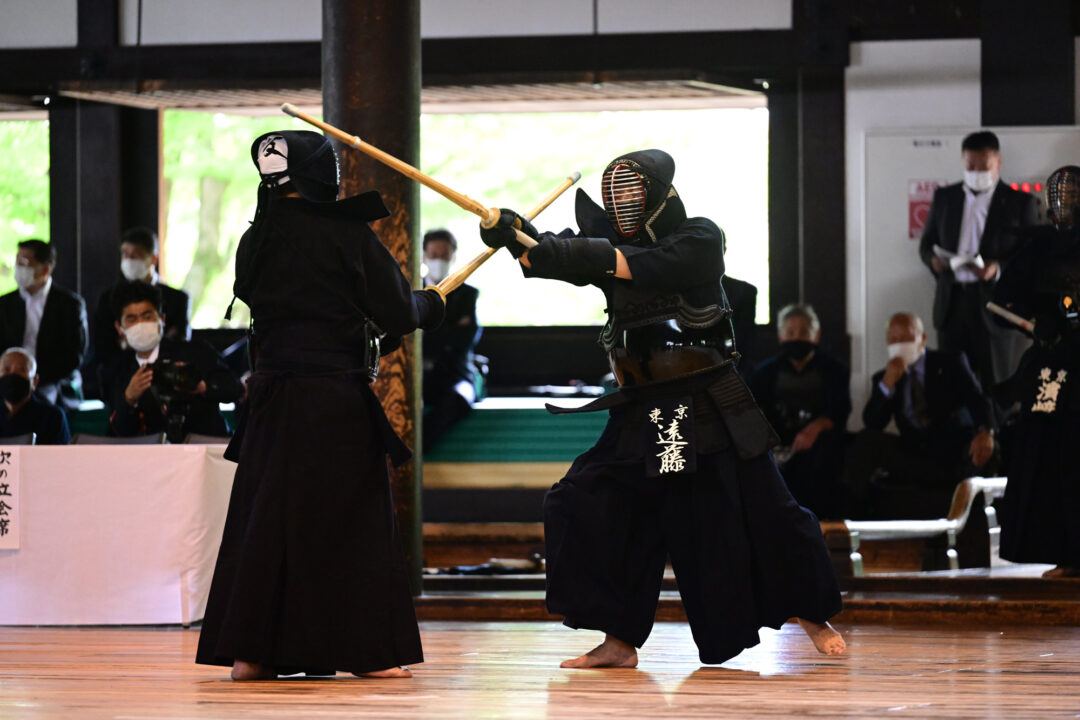2023.10 KENDOJIDAI
Photography: Nishiguchi Kunihiko
Translation: Jouke van der Woude
“To build up Tame and follow through with a strike, one must strike decisively, casting aside hesitation. It’s challenging, but it’s an essential element in real fights and examinations” emphasizes Hanshi Endo Masaki. We will explore how to acquire the technique of building up Tame and following through, which is a universal challenge in Kendo.
Endo Masaki, Hanshi 8th dan

Accumulating power before exerting it
Gradually accumulating knowledge
In this discussion, I’d like to explore the themes of “Tame” and “following through.” During Kendo Keiko, many of us have probably received advice from our Sensei to the tune of “Your Kendo lacks Tame. Build it up properly during Keiko.” I, too, received such guidance from various Sensei in my twenties. At that time, when they told me to build up Tame, I didn’t quite understand what they meant. I only thought about not immediately executing a technique but instead observing my opponent carefully before striking. In my thirties, forties, fifties, and sixties, as I accumulated experience from Shiai and Keiko, I gradually developed my own understanding of the depth of Tame. However, I don’t know if my perspective is correct. So, I decided to investigate the original meaning of Tame. It means gradually accumulating things like money or knowledge. It also involves withholding and storing power until the very last moment before releasing it. In the context of Shogi (Japanese form of chess) terminology, it’s like capturing your opponent’s pieces and increasing your reserve pieces without immediately attacking, or add to the the influence of your pieces to strengthen your attacking position.
Looking at it this way, we can see that there are many commonalities between Kendo and these concepts. Tame in Kendo requires the development of keen observational skills to assess your opponent effectively. Think of the Japanese Kendo Kata. The Uchidachi waits for the right moment to execute a technique, while the Shidachi strikes. The ability to seize the right moment is crucial and directly relates to Tame. Additionally, the time spent building up Tame becomes essential. When facing an opponent, both parties watch for openings and engage in offensive and defensive maneuvers. During this process, it’s important to conserve mental and physical energy without letting up and firmly store it while concentrating power in your lower abdomen. Simultaneously, it’s crucial to accumulate energy in the rest of your body. In particular, we focus on our left foot, preparing it to strike instantly. As we become higher-ranking practitioners, we strive to refine our Keiko to shorten the time it takes to build up Tame.
Following through is to strike with abandon
The term “Uchikiru” (following through with a strike) is often used in Kendo as well. Let’s ponder on what it means to follow through and how one can achieve it. In the end, following through can be understood as a strike where you strike with abandon. In other words, it greatly depends on the mental aspect and one’s state of mind during the striking motion. It’s about reaching a state where your mind becomes void the moment you strike. This void is like hitting with absolute certainty, creating an instant blankness in your mind. Creating a blankness might seem unfavorable in Kendo, but since you’ve reached a void, the space quickly becomes filled with energy. In Kendo terms, it means your spirit and determination become more concentrated instantly before the strike. This state can be described as following through. However, achieving this requires significant mental commitment. When it comes time to strike, doubts can arise, such as whether your Kote will be struck or if your opponent will counter with Kaeshi-do. Overcoming these doubts and striking decisively is incredibly challenging.
Yet, if your strike is successful, for that brief moment, it feels like time stands still. If you can deliver such strikes during a Dan examination, you are almost certain to pass. I participated as both a referee and a demonstrator at this year’s Kyoto Tournament. Even after witnessing numerous Shiai and engagements, I rarely saw strikes that truly embodied follow-through. It’s evident that this aspect of Kendo is exceedingly difficult.
Therefore, it’s crucial to cultivate the ability to build up Tame through regular Keiko. Tame and following through are not separate entities; they are part of a continuous process in Kendo, encompassing Suburi and Uchikomi. Keep this in mind as you aim for Kendo ten years from now, and let’s work hard to improve our skills.
Tenouchi is vital
Practicing Suburi with the spirit in the Kensaki
The rest of this article is only available for Kendo Jidai International subscribers!



